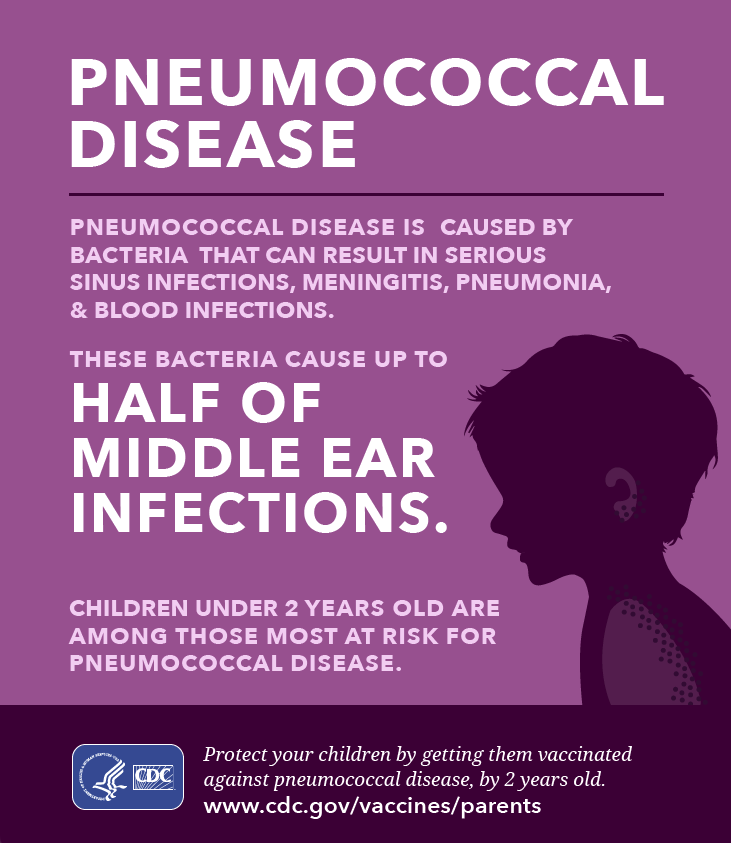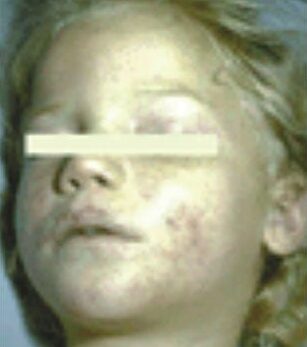Pneumococcal Disease
What is pneumococcal disease?
Pneumococcal disease is caused by the bacteria Streptococcus pneumoniae (S. pneumoniae). It spreads through coughing and sneezing and is most common in young children, though older adults are at the highest risk for invasive disease/severe illness and death.
Types of pneumococcal disease include pneumonia (lung infection), meningitis (infection of the lining of the brain and spinal cord), bloodstream infections (bacteremia and sepsis), as well as middle ear and sinus infections.
On this page, you can explore how pneumococcal disease spreads, who is at risk, what the symptoms are, how common pneumococcal disease is in children, and how to prevent it.
children who get pneumococcal meningitis will die.
How does pneumococcal disease spread?
Pneumococcal bacteria spread through direct contact with respiratory secretions, such as saliva or mucus, often via actions like coughing or sneezing.

Children under the age of 5 and adults 65 years or older are at increased risk for pneumococcal disease. Additionally, Black, Alaskan Natives and certain American Indians face a higher rate of pneumococcal disease beginning at the age of 50. Some adults 19 through 64 years old are also at increased risk, including those:
- With chronic illnesses (lung, heart, liver, or kidney disease; COPD; asthma; diabetes; or alcoholism)
- With conditions that weaken their immune system (HIV/AIDS, cancer, or damaged/absent spleen)
- Living in nursing homes or other long-term care facilities
- Who smoke cigarettes
- With cochlear implants
It is also important to get a flu shot every year because having the flu increases your chances of getting pneumococcal pneumonia.
What are the symptoms of pneumococcal disease?
Symptoms of pneumococcal disease vary depending on the type but typically include fever and/or chills. Additional symptoms may include:
- Pneumonia: Cough (often with mucus), rapid breathing or difficulty breathing, chest pain, and nausea/vomiting/diarrhea
- Meningitis: Stiff neck, headache, confusion, sensitivity to bright light, poor eating and drinking, drowsiness,nausea/vomiting, and seizures. Symptoms may appear different in children and infants.
- Bacteremia: Fast heart rate, low blood pressure, abdominal pain, nausea/vomiting, and rapid breathing
- Middle Ear Infection: Ear pain (especially when laying down), drainage of fluid from the ear, trouble hearing, and trouble sleeping. Children may tug or pull on their ear, appear off balance, and cry more than usual.


Children are the most vulnerable. About 1,500 cases of serious pneumococcal disease occur each year in children under 5 in the U.S.
How common is pneumococcal disease in children?
According to the CDC, each year in the United States, pneumococcus causes thousands of cases of pneumonia and ear infections.
Pneumococcal disease is the most common bacterial cause of childhood pneumonia, especially in children younger than age 5 years. These illnesses can lead to disabilities such as deafness, brain damage, or loss of arms or legs. About 1 in 12 children who get pneumococcal meningitis will die. About 1 in 30 children with bacteremia will die.
How can I prevent pneumococcal disease?
Pneumococcal vaccines are the most effective way to prevent pneumococcal disease in children, teens, and adults. In the U.S., two types of pneumococcal vaccines are available: pneumococcal conjugate vaccines (PCV15, PCV20, and PCV21) and the pneumococcal polysaccharide vaccine (PPSV23).


Babies and Children
The CDC recommends pneumococcal vaccination for all children under 5 years old. Children should be given 4 doses of a pneumococcal vaccine (PCV15 or PCV20) according to the recommended childhood schedule. One dose should be given at age:
- 2 months
- 4 months
- 6 months
- 12 through 15 months
Children 2–18 years old with certain medical conditions may get additional pneumococcal vaccine doses according to their healthcare provider.


Adults
The CDC recommends pneumococcal vaccination for all adults 50 years or older and younger adults (19–49 years) with specific medical conditions.
In October 2024, the CDC updated its pneumococcal vaccine recommendations for adults by lowering the recommended age for vaccination from 65 to 50. This change intends to reduce the relatively high instance of preventable pneumococcal disease in adults age 50 through 64 years and improve health equity.
If PCV15 is used, it should be followed by a dose of PPSV23 at least 8 weeks to 1 year later, if the individual has not previously had a dose of PPSV23.
If an adult is vaccinated with one dose of PCV20 or PCV21, their pneumococcal vaccination is complete.
Learn more about these new CDC recommendations.
CDC Recommended Vaccination Schedules
To ensure that your entire family is up to date on their vaccines, check out the following CDC recommended immunization schedules and talk to your healthcare provider.
Since there are more than 90 known strains of S. pneumoniae bacteria that cause pneumococcal disease, a previous pneumococcal infection will not protect you from getting the disease again. Therefore, pneumococcal vaccines are still recommended for people who have had pneumococcal disease in the past.


